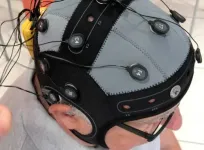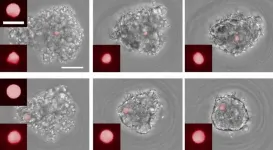(Press-News.org) Rain falls lightly on the ocean's surface. Marine mammals chirp and squeal as they swim along. The pounding of surf along a distant shoreline heaves and thumps with metronomic regularity. These are the sounds that most of us associate with the marine environment. But the soundtrack of the healthy ocean no longer reflects the acoustic environment of today's ocean, plagued with human-created noise.
A global team of researchers set out to understand how human-made noise affects wildlife, from invertebrates to whales, in the oceans, and found overwhelming evidence that marine fauna, and their ecosystems, are negatively impacted by noise. This noise disrupts their behavior, physiology, reproduction and, in extreme cases, causes mortality. The researchers call for human-induced noise to be considered a prevalent stressor at the global scale and for policy to be developed to mitigate its effects.
The research(link is external), led by Professor Carlos M. Duarte, distinguished professor at King Abdullah University of Science and Technology (KAUST), and published in the journal Science, is eye opening to the global prevalence and intensity of the impacts of ocean noise. Since the Industrial Revolution, humans have made the planet, the oceans in particular, noisier through fishing, shipping, infrastructure development and more, while also silencing the sounds from marine animals that dominated the pristine ocean.
"The landscape of sound - or soundscape - is such a powerful indicator of the health of an environment," noted Ben Halpern(link is external), a coauthor on the study and director of the National Center for Ecological Analysis and Synthesis at UC Santa Barbara. "Like we have done in our cities on land, we have replaced the sounds of nature throughout the ocean with those of humans."
The deterioration of habitats, such as coral reefs, seagrass meadows and kelp beds with overfishing, coastal development, climate change and other human pressures, have further silenced the characteristic sound that guides the larvae of fish and other animals drifting at sea into finding and settling on their habitats. The call home is no longer audible for many ecosystems and regions.
The Anthropocene marine environment, according to the researchers, is polluted by human-made sound and should be restored along sonic dimensions, and along those more traditional chemical and climatic. Yet, current frameworks to improve ocean health ignore the need to mitigate noise as a pre-requisite for a healthy ocean.
Sound travels far, and quickly, underwater. And marine animals are sensitive to sound, which they use as a prominent sensorial signal guiding all aspects of their behavior and ecology. "This makes the ocean soundscape one of the most important, and perhaps under-appreciated, aspects of the marine environment," the study states. The authors' hope is that the evidence presented in the paper will "prompt management actions ... to reduce noise levels in the ocean, thereby allowing marine animals to re-establish their use of ocean sound."
"We all know that no one really wants to live right next to a freeway because of the constant noise," commented Halpern. "For animals in the ocean, it's like having a mega-freeway in your backyard."
The team set out to document the impact of noise on marine animals and on marine ecosystems around the world. They assessed the evidence contained across more than 10,000 papers to consolidate compelling evidence that human-made noise impacts marine life from invertebrates to whales across multiple levels, from behavior to physiology.
"This unprecedented effort, involving a major tour de force, has shown the overwhelming evidence for the prevalence of impacts from human-induced noise on marine animals, to the point that the urgency of taking action can no longer be ignored," KAUST Ph.D. student Michelle Havlik said. The research involved scientists from Saudi Arabia, Denmark, the U.S. and the U.K., Australia, New Zealand, the Netherlands, Germany, Spain, Norway and Canada.
"The deep, dark ocean is conceived as a distant, remote ecosystem, even by marine scientists," Duarte said. "However, as I was listening, years ago, to a hydrophone recording acquired off the U.S. West Coast, I was surprised to hear the clear sound of rain falling on the surface as the dominant sound in the deep-sea ocean environment. I then realized how acoustically connected the ocean surface, where most human noise is generated, is to the deep sea; just 1,000 m, less than 1 second apart!"
The takeaway of the review is that "mitigating the impacts of noise from human activities on marine life is key to achieving a healthier ocean." The KAUST-led study identifies a number of actions that may come at a cost but are relatively easy to implement to improve the ocean soundscape and, in so doing, enable the recovery of marine life and the goal of sustainable use of the ocean. For example, simple technological innovations are already reducing propeller noise from ships, and policy could accelerate their use in the shipping industry and spawn new innovations.
Deploying these mitigation actions is a low hanging fruit as, unlike other forms of human pollution such as emissions of chemical pollutants and greenhouse gases, the effects of noise pollution cease upon reducing the noise, so the benefits are immediate. The study points to the quick response of marine animals to the human lockdown under COVID-19 as evidence for the potential rapid recovery from noise pollution.
Using sounds gathered from around the globe, multimedia artist and study coauthor Jana Winderen created a six-minute audio track that demonstrates both the peaceful calm, and the devastatingly jarring, acoustic aspects of life for marine animals. The research is truly eye opening, or rather ear opening, both in its groundbreaking scale as well as in its immediacy.
INFORMATION:
In the framework of the Chlorella microalgae cultivation process, the researchers from Peter the Great St.Petersburg Polytechnic University (SPbPU) obtained microalgae biomass with a high content of carotenoid pigments, which is suitable for the food industry. The research results were published Nov. 2020 in the scientific journal "Agronomy Research".
The deterioration of the ecological status of urban areas and the industrialization of the food industry requires the additional enrichment of the diet with biologically valuable food substances. Such pigments as carotenoids, from which vitamin A is synthesized in the body, are ...
Astronomers have for the first time used distant galaxies as 'scintillating pins' to locate and identify a piece of the Milky Way's missing matter.
For decades, scientists have been puzzled as to why they couldn't account for all the matter in the universe as predicted by theory. While most of the universe's mass is thought to be mysterious dark matter and dark energy, 5 percent is 'normal matter' that makes up stars, planets, asteroids, peanut butter and butterflies. This is known as baryonic matter.
However, direct measurement has only accounted for about half ...
Using AI and computer automation, Technion researchers have developed a "conjecture generator" that creates mathematical conjectures, which are considered to be the starting point for developing mathematical theorems. They have already used it to generate a number of previously unknown formulas. The study, which was published in the journal Nature, was carried out by undergraduates from different faculties under the tutelage of Assistant Professor Ido Kaminer of the Andrew and Erna Viterbi Faculty of Electrical Engineering at the Technion.
The project deals with one of the most fundamental elements of mathematics - mathematical constants. ...
When treating cancer, researchers are always searching for ways to remove cancer cells while minimizing damage to the rest of the body. One possible approach is to find processes unique to cancer cells, and which would allow specific targeting. If such a process can be disrupted, only those cells would be affected.
A process (or absence thereof) can be unique to some types of cancer, and not be present in others. In such a case, we would want a simple way to recognize whether a particular tumor possesses the unique trait or not. The implication of this question is whether the tumor would respond to ...
Researchers from the HSE Institute for Cognitive Neuroscience have proposed a new method to process magnetoencephalography (MEG) data, which helps find cortical activation areas with higher precision. The method can be used in both basic research and clinical practice to diagnose a wide range of neurological disorders and to prepare patients for brain surgery. The paper describing the algorithm was published in the journal NeuroImage.
Magnetoencephalography (MEG) is a method based on measuring very weak magnetic fields (several orders of magnitude weaker than the Earth's magnetic field) induced by the brain's electrical activity. When using MEG, researchers face the complicated task ...
Professionalisation in any field requires long-term experience and training. In the past decades, studies have demonstrated that the professionalisation of athletes and artists create differences in the behaviour of the brain while carrying out activities related to their area of expertise.
To detect the effects of media professionalisation in the brain, a research team from the Universitat Autònoma de Barcelona, the Instituto Ràdio Televisió Espanyola and the Universidad Pablo de Olavide in Seville conducted a study published in Frontiers in Systems Neuroscience in which audiovisual contents were presented to a group of media ...
Machines, thanks to novel algorithms and advances in computer technology, can now learn complex models and even generate high-quality synthetic data such as photo-realistic images or even resumes of imaginary humans. A study recently published in the international journal PLOS Genetics uses machine learning to mine existing biobanks and generate chunks of human genomes which do not belong to real humans but have the characteristics of real genomes.
"Existing genomic databases are an invaluable resource for biomedical research, but they are either not publicly accessible or shielded behind long and exhausting application procedures due to valid ethical concerns. This creates a major scientific barrier for researchers. Machine-generated genomes, or artificial ...
PROVIDENCE, R.I. [Brown University] -- A new technique developed by Brown University researchers reveals the forces involved at the cellular level during biological tissue formation and growth processes. The technique could be useful in better understanding how these processes work, and in studying how they may respond to environmental toxins or drug therapies.
As described in the journal Biomaterials, the technique makes use of cell-sized spheres made from a highly compliant polymer material, which can be placed in laboratory cultures of tissue-forming cells. As the tissue-formation process unfolds, microscope imaging of the spheres, which are stained with fluorescent dye, reveals the extent to which they are deformed by the pressure of surrounding cells. A ...
Bird species that live in their natural habitats can help zoos learn how to manage those in captivity, according to a new review.
Birds are the most diverse group housed by zoos around the world, but zoo-based research tends not to focus on birds.
A new article published in the journal Birds, by Dr Paul Rose of the University of Exeter, suggests zoos can improve management of birds by looking at how species live in their natural habitats.
Likewise, birds living under the care of humans can also help guide and develop conservation action for those living in the wild.
"Research into wild birds is extremely useful for furthering how birds are managed in zoos," said ...
Scientists have made a significant breakthrough in the quest to understand the intricate processes that occur in the brain during seizures that are the key symptom of epilepsy.
A team of scientists from the University of Exeter has studied the mechanisms behind distinctive patterns of electrical activity of neuron groups in the brain that accompany the onset of seizures.
In healthy brains, networks of neurons move through states of similar behavior - known as synchronization - and dissimilar behavior, called desynchronization. These processes are also associated with both memory and attention.
However, in a brain with a neurological disorder, such as epilepsy, ...




